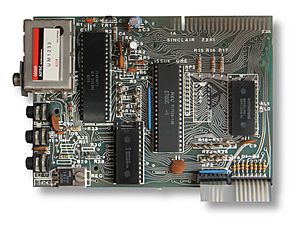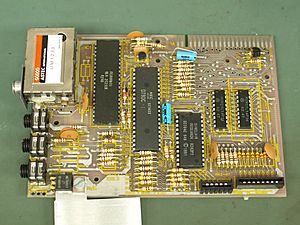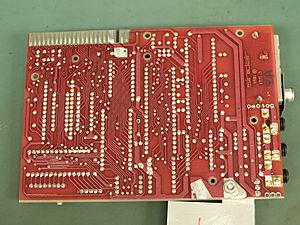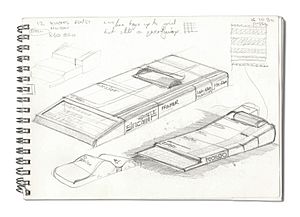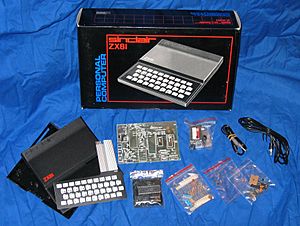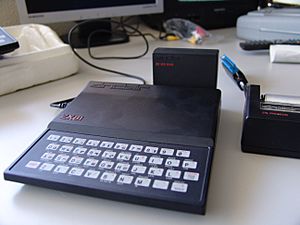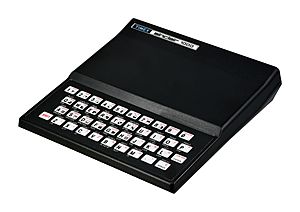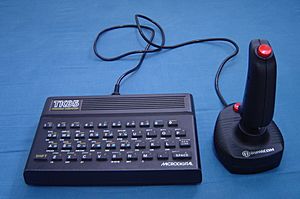ZX81 facts for kids
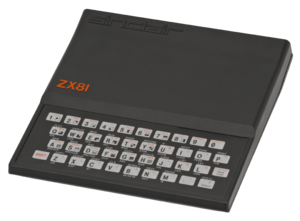 |
|
| Developer | Sinclair Research |
|---|---|
| Manufacturer | Timex Corporation |
| Type | Home computer |
| Release date | 5 March 1981 |
| Introductory price | £49.95 kit, £69.95 assembled (£138–193/$189–264 at 2025 prices) |
| Discontinued | 1984 |
| Units sold | More than 1.5 million |
| Operating system | Sinclair BASIC |
| Power | 9V DC |
| CPU | Z80 @ 3.25 MHz |
| Memory | 1 KB (64 KB max. 56 KB usable) |
| Storage | External Compact Cassette recorder at a claimed 250 bps or an average 300 bps |
| Display | Monochrome display on UHF television |
| Graphics | 24 lines × 32 characters or 64 × 48 pixels graphics mode |
| Dimensions | 167 millimetres (6.6 in) wide by 175 millimetres (6.9 in) deep |
| Weight | 350 grams (12 oz) |
| Predecessor | ZX80 |
| Successor | ZX Spectrum |
| Related articles | Timex Sinclair 1000, Timex Sinclair 1500 |
The ZX81 was a home computer made by Sinclair Research in the UK. It was first released in March 1981. This computer was designed to be a cheap and easy way for people to start using computers at home. It was very popular, selling over 1.5 million units!
In the United States, it was sold as the ZX-81 by Timex. Timex later made its own versions, called the Timex Sinclair 1000 and Timex Sinclair 1500. Other companies in different countries also made their own copies of the ZX81.
The ZX81 was made to be small, simple, and very affordable. It used only four silicon chips and had just 1 KB of memory. You could connect it to a regular TV to see what you were doing. Programs and data were saved and loaded using compact audio cassettes, like music tapes. It didn't even have a power switch! The computer had a flat, touch-sensitive membrane keyboard. Because it was so simple, many other companies made extra parts to make it better. The unique look of the ZX81 even won its designer, Rick Dickinson, an award.
You could buy the ZX81 already put together or as a kit that you built yourself for a lower price. It was the first cheap home computer sold in regular stores, like W. H. Smith. The ZX81 helped make computing popular for everyone in Britain, not just business people or electronics experts. It created a huge community of fans. Many of these fans started their own businesses, making software and hardware for the ZX81. Some even became important people in the British computer industry later on. The ZX81's success made Sinclair Research a top computer maker in Britain. It also made the company's founder, Sir Clive Sinclair, very rich and earned him a special award called a knighthood.
Contents
What the ZX81 Could Do
The ZX81 came with 1 KB of built-in memory. You could add more memory externally, up to 16 KB. The computer was very light, weighing only about 350 grams. It had a single circuit board inside a wedge-shaped plastic case.
The memory used special chips, and there were only three other main chips inside. These included a Z80A microprocessor and a special chip called an uncommitted logic array (ULA). There was also an 8 KB ROM chip that held a simple Sinclair BASIC program. This program helped you write commands for the computer.
The front of the computer had a flat, touch-sensitive keyboard with 40 keys. These keys could do many things. Each key had up to five functions, depending on whether you pressed the SHIFT or FUNCTION keys. For example, the "P" key could type the letter "P", the " character, or the BASIC commands "PRINT" and "TAB". The keyboard used a standard QWERTY layout, just like most modern keyboards.
Connecting to the World
The ZX81 had four ports on its left side for connecting other devices. It used a regular UHF television to show a black and white picture. The screen could display 24 lines of 32 characters. It could also show simple graphics using blocks, which was like a 64 × 44 pixel graphics mode. You could draw these graphics using BASIC commands like PLOT and UNPLOT.
Two small jacks connected the ZX81 to an audio cassette recorder. This allowed you to save your programs and data onto cassette tapes or load them back into the computer. This was the only way to store information, as the ZX81 didn't have built-in storage. The ZX81 needed a special 9V power supply to work.
The ULA Chip: A Computer's Brain
The ULA chip was like the "dogsbody" (a hard worker) of the ZX81 system. It did many important jobs that other computers needed multiple chips for. These jobs included:
- Making sure the screen display worked correctly.
- Creating the computer's internal clock speed.
- Sending audio signals to the cassette recorder when saving data.
- Reading audio signals from the cassette recorder when loading data.
- Detecting which keys were pressed on the keyboard.
- Helping the main processor decide when to use the ROM or RAM memory.
- Controlling the overall timing of the system.
Both the ZX81 and its older brother, the ZX80, had a small problem with how they showed things on screen. They weren't powerful enough to run at full speed and keep the screen display going at the same time. On the ZX80, the screen would go blank every time the computer did a calculation. This caused an annoying flicker.
The ZX81 improved this by having two modes: SLOW and FAST. In SLOW mode, the computer focused on showing the display. This meant it ran programs about four times slower. In FAST mode, the computer ran programs continuously at full speed, but the screen display would be turned off or show strange patterns.
Another interesting thing about the ZX81's display was the moving zigzag stripes you would see when loading or saving programs. This happened because the same part of the ULA chip handled both the video signal and the tape output. This caused interference, creating the zigzag patterns.
Making the Most of Little Memory
The ZX81 had very little memory, which was a big challenge for programmers. Just showing a full screen of text used up a lot of memory. Despite this, clever programmers managed to do amazing things with just 1 KB. For example, a chess program called Super Micro Chess Engine included all the rules of chess in this tiny space!
The ZX81 saved memory by using special "tokens" for common BASIC commands. Instead of typing "PRINT", you might just press one key, and the computer would store it as a single "character" token. This saved a lot of space.
The back of the ZX81 had an "edge connector". This allowed people to connect external devices to the computer. Many fans and companies used this to create a wide range of add-ons for the ZX81.
How the ZX81 Compared to Other Computers
The ZX81 was much cheaper than other computers available in 1981. Here's a quick look at how it stacked up:
| Device | RAM standard | Expandable to | CPU | Keyboard | BASIC | Sale price | Number of colours |
Maximum resolution |
Sound |
|---|---|---|---|---|---|---|---|---|---|
| Apple II Plus | 16 KB | 48 KB | MOS Technology 6502 @ 1 MHz (8-bit) | Typewriter | Integer only | £549 | 16 | 280 × 192 pixels | beeper |
| Atari 400 | 8 KB | 48 KB | MOS Technology 6502 @ 1.78 MHz (8-bit) | Membrane | extra | £289 | 256 | 320 × 192 pixels | 4 voice |
| PET | 16 KB | 40 KB | MOS Technology 6502 @ 1 MHz (8-bit) | Typewriter | MS Level I | £399 | Monochrome | 320 × 200 text only | beeper |
| VIC-20 | 5 KB | 32 KB | MOS Technology 6502 @ 1.02 MHz (8-bit) | Typewriter | MS Level I | £189 | 8 | 176 × 184 pixels | 4 voice |
| Video Genie | 16 KB | 48 KB | Zilog Z80 | Typewriter | MS Level II | £279 | Monochrome | 128 × 48 block | beeper |
| Compukit 101 | 1 KB | 48 KB | MOS Technology 6502 | Typewriter | MS Level II | £149/£199 assembled | Monochrome | 128 × 48 block | extra |
| TRS-80 Model I | 4 KB | 48 KB | Zilog Z80 @ 1.78 MHz (8-bit) | Typewriter | Restricted | £399 | Monochrome | 128 × 48 block | extra |
| Acorn Atom | 2 KB | 12 KB | MOS Technology 6502 @ 1 MHz | Typewriter | TinyBASIC hybrid | £140/£173 assembled | 8 | 256 × 192 mono, 64 × 64 colour | beeper |
| MicroTan | 1 KB | 48 KB | MOS Technology 6502 | extra | extra | £65/£99 assembled | Monochrome | 128 × 48 block | extra |
| TI-99/4A | 16 KB | 48 KB | TI TMS9900 @ 3.0 MHz (16-bit) | Typewriter | Restricted | £399 | 16 | 256 × 192 pixels | 3 voices and white noise |
| ZX81 / TS1000 | 1 KB / 2 KB | 32 KB | Zilog or NEC Z80 @ 3.25 MHz (8-bit) | Membrane | MS Level II equiv. | £49/£69 assembled | Monochrome | 64 × 48 block | No |
How the ZX81 Was Made
The ZX81 was developed even before the ZX80 was launched. Sinclair's chief engineer, Jim Westwood, worked to improve the ZX80's hardware. His goal was to use fewer parts and make the computer cheaper. He also wanted to fix some of the ZX80's annoying problems.
Westwood and his team found a way to combine many of the ZX80's chips into one special chip called an uncommitted logic array (ULA). This made the ZX81 much simpler and cheaper to build. Sinclair was very proud of this design, saying the ZX81 had only four chips, while its closest competitor had 44!
The ZX81's ROM (Read-Only Memory) was made bigger, from 4 KB in the ZX80 to 8 KB. This allowed for a more complete version of Sinclair BASIC. Two programmers, John Grant and Steve Vickers, wrote the new software for the ROM. Grant focused on the hardware, while Vickers developed the new BASIC language and wrote the instruction manual.
The new BASIC could do trigonometry and work with decimal numbers, which the ZX80 couldn't do. Grant also added a cool feature: a syntax checker. This checker would tell you if you made a mistake in your BASIC code as soon as you typed it, instead of waiting until you ran the program.
Rick Dickinson designed the ZX81's case, making an updated version of the ZX80's wedge shape. This time, they used a better manufacturing method called injection moulding, which made the case higher quality. The whole design process took about six months.
The ZX81 was launched on March 5, 1981. You could buy it already built or as a cheaper kit you put together yourself. Both versions were made in Dundee, Scotland, by Timex Corporation. Timex was known for making watches but wanted to try making electronics.
Timex had some trouble at first making enough ZX81s to meet the high demand. It could take up to nine weeks for mail-order ZX81s to be delivered. By September 1981, delivery times finally improved to the promised 28 days. If you owned a ZX80, you could upgrade it to a ZX81 by plugging in a new £20 ROM chip.
Some people worried about the ZX81's reliability. However, Sinclair claimed that only 2.4% of pre-assembled machines were returned. They said the higher return rate for kits was because customers sometimes broke parts while building them. Sinclair also had a reputation for slow customer service, which meant repairs could take months.
How the ZX81 Was Advertised
Sinclair used big, eye-catching advertisements to sell the ZX81. They wanted to reach both computer fans and everyday people who knew nothing about computers. The ads showed that you didn't need to be a computer genius to use one. Clive Sinclair believed that if they offered a computer with a learning book at a good price, people would buy it.
The low price of the ZX81 opened up a completely new market. Many people who had never thought about owning a computer before decided to buy one. The ads often highlighted the ZX81's value for money, with prices printed in large letters. The slogan "Sinclair ZX81 Personal Computer – the heart of a system that grows with you" showed its potential.
The advertisements also stressed the educational benefits. They said it was "still very simple to teach yourself computing." The manual, written by Steve Vickers, was called "a complete course in BASIC programming." The ads also pointed out that the ZX81 was "designed by Sinclair and custom-built in Britain."
In the United States, Sinclair's ads focused on how the ZX81 could help children learn about computers. They also suggested it could help adults make smart choices about computers for their careers and homes.
Clive Sinclair himself became a big part of the marketing. He was seen as a British inventor taking on big American and Japanese companies. The media even called him "Uncle Clive" and a "visionary genius."
The price was a key part of the marketing. The ZX81 was designed to cost around £70 and launched at £69.95 (built) or £49.95 (kit). Sinclair often lowered prices to keep sales high and stay ahead of competitors. This strategy worked very well. By March 1982, Sinclair had sold 250,000 ZX81s worldwide. Even in July 1983, two years after its launch, the ZX81 was still selling over 30,000 units a month. By then, over 1.5 million ZX81s had been sold.
Where You Could Buy a ZX81
The way the ZX81 was sold was a big reason for its success. Sinclair first sold it by mail order. But to reach even more people, they needed to sell it in stores. W.H. Smith, a well-known book and magazine store, helped with this.
W.H. Smith wanted to update its image and sell new products. They started selling computer books and magazines. When they saw how popular the ZX80 was, they decided to sell the ZX81 exclusively for the first six months. They created "Computer Know-How" sections in their stores, selling the ZX81 along with software and blank cassette tapes.
Selling the ZX81 in stores was a bit of a risk. But it was a huge success for W.H. Smith. The "Computer Know-How" sections were packed with excited customers, especially schoolchildren. Within a year, Smith's sold 350,000 ZX81s.
Other British stores like Boots, John Menzies, and Currys started selling the ZX81 after Smith's exclusive deal ended. The ZX81 was also sold in 18 other countries by March 1982.
In the United States, Sinclair launched the ZX81 in November 1981. It cost $149.95 assembled or $99.95 as a kit. Sales quickly reached 15,000 a month. In February 1982, Timex got a license to sell the ZX81 directly in thousands of US stores. Timex later made its own versions of the ZX81.
The ZX81 was even sold in duty-free shops at UK airports for a while. However, the government stopped this to prevent the computers from being taken to Soviet bloc countries. These countries sometimes tried to copy Western technology.
Extra Parts and Programs
The ZX81's popularity quickly led to many people making their own extra parts (peripherals) and software for it. Sinclair itself didn't make many programs, leaving a big market for other companies. W.H. Smith even sold cheap cassette recorders as "data recorders" because they worked better for the ZX81 than expensive music systems.
Sinclair only released two official add-ons for the ZX81:
- A 16 KB RAM pack: This added more memory. However, it was top-heavy and often wiggled loose, causing the computer to crash and lose your work. Users sometimes used tape or chewing gum to keep it in place!
- The ZX Printer: This was a tiny printer that "burned" images onto special silver paper. It worked okay at first but got worse over time.
Many other companies made their own peripherals to fix the ZX81's problems or add new features. These included RAM packs that stayed put, typewriter-style keyboards, better printers, and sound generators. A huge variety of software was also released. Within a year, about 200 independent companies were making Sinclair-compatible hardware. Many of these companies were started by regular people, like teachers or engineers, working from home.
The ZX81's popularity was clear at events like the "ZX Microfair" in January 1982. Thousands of people, mostly young people, came from all over Britain to see and buy software and hardware. The police even had to control the huge crowds! This fair showed how important third-party companies were to the ZX81's success, as their stalls were much more crowded than Sinclair's own booth.
Thousands of ZX81 programs were published. Many computer magazines printed program listings that you could type in yourself. Many individuals became "bedroom programmers," creating games and applications and selling them from their homes. Some even started their own software companies.
Some of the most famous ZX81 games used only text characters and simple graphics. One example is 3D Monster Maze, a scary game where you had to escape a maze with a Tyrannosaurus rex chasing you. It was one of the first 3D games for home computers.
Even music companies tried to get in on the action! In 1983, EMI released a music single with a ZX81 program recorded on the B-side.
Other Versions and Copies
Sinclair's deal with Timex allowed the American company to make its own versions of Sinclair computers for the US market. These included the Timex Sinclair 1000 and Timex Sinclair 1500, which were based on the ZX81.
The TS1000 was launched in July 1982 and caused a huge stir. It was almost exactly like the ZX81 but had 2 KB of memory instead of 1 KB. In just five months, Timex sold 550,000 TS1000s.
Timex also made the TS1500, which was like an American ZX81 with a better keyboard and 16 KB of memory. However, it wasn't as successful because of more competition and problems with how Timex sold the TS1000. Timex didn't provide the important RAM pack upgrades for months after the TS1000 launched. This meant people bought the computer, took it home, and found it couldn't do much without more memory.
Also, American buyers were different from British ones. They wanted computers for business or fun, with ready-made programs, color, and sound. The TS1000's low price wasn't enough when other computers like the TI-99/4A and VIC-20 also dropped their prices. Many American stores stopped selling Timex Sinclair computers.
Some companies outside the US and UK made their own "pirate" copies of the ZX81. For example, several Brazilian companies made ZX81 clones, like the TK series. An Argentinian company made the CZ1000 and CZ1500. A company in Hong Kong made the Lambda 8300, which was also copied by other Chinese makers. These copies weren't always exact; some added more memory or a better keyboard.
The ZX81's Lasting Impact
The ZX81 had a big and immediate effect on Sinclair Research and Clive Sinclair. The company's profits grew a lot. Clive Sinclair became a famous businessman and a millionaire. He even received a knighthood in 1983.
The computer also had a huge and lasting impact on people in the United Kingdom. Many different kinds of people bought the ZX81, from those who read serious newspapers to those who read popular tabloids. The biggest group of buyers was around 30 years old. Many older users, often parents, became fascinated by the ZX81s they bought for their children.
One of the most important things the ZX81 did was encourage many people to try computer programming for the first time. In William Gibson's novel Pattern Recognition, a character explains that the ZX81 led to many skilled programmers in the UK. This was because the computer was cheap but required users to type in their own programs.
Many famous people had their first computer experience with the ZX81. These include author Terry Pratchett and many video game developers like Charles Cecil and David Perry.
Even more than 30 years after its launch, the ZX81 still has active user communities online. New hardware and software are still being made for it. For example, there's a ZX81-based webserver and a device called ZXpand that adds an SD card slot and more memory. New games are also still being released on cassette tape by companies like Cronosoft and Revival Studios.
Images for kids



